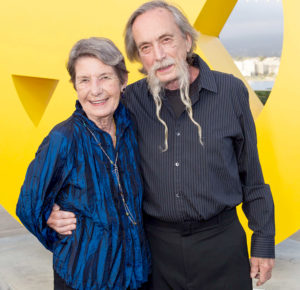Cosmic Pipes
4/20: Well before 1967’s Summer of Love, Northern California was home to a vibrant counterculture that provided musicians, writers, and artists with affordable rent and a variety of spaces to create and share their work. In 1957, artist Bruce Conner moved from New York to San Francisco, and soon attracted a coterie of bohemian artists including Joan Brown, Wallace Berman, Michael McClure, Jay De Feo, and Wally Hedrick. In addition to his energy and charisma, Conner proved to be something of a Johnny Appleseed of illicit substances. Years before LSD arrived on the scene via university psychiatric experiments, Conner and his compatriots began experimenting with peyote, which had been used in Indigenous religious ceremonies for millennia.
It goes without saying that cannabis use dovetailed with the potpourri of substances used within the counterculture. Although it was made illegal on a federal level in 1937 after a wave of racist and xenophobic propaganda claiming that it caused Black and Hispanic users to commit crimes, cannabis use remained robust among bohemian artists. As the 1960s evolved, marijuana proliferated in ever-widening circles, permeating youth culture.
San Francisco
In 1968, Wisconsin-born ceramic artist Clayton Bailey moved to Northern California and took up residence with his family in an old diner in Crockett, a blue-collar town north of San Francisco. Bailey, along with his wife Betty, immediately fell in with a circle of artists that revolved around the University of California-Davis’s quirky art department that included luminaries such as Robert Arneson, William T. Wiley, and Roy De Forest. Davis alumni Maija Zack (now Maija Peeples-Bright) and David Gilhooly rounded out a rowdy creative scene that frequently gathered at the Zack’s eye-popping Rainbow House in San Francisco’s Haight-Ashbury district and De Forest’s rural property near Port Costa.
Along with copious amounts of Swan Lager—their beer of choice — other substances were certainly on the menu! With the number of children around, as well as the prying eyes of law enforcement, Betty Bailey began making what she called Paranoid Pipes in the shape of ice cream cones, flowers, and other innocent-looking objects. This soon became a group project, with artists creating pipes in the shape of everything from chocolate bars to pangolins, sometimes brushing function aside in favor of whimsy.
What started as a group of like-minded friends evolved into an art movement. According to Maija Zack’s then husband David, the Nut Art movement was birthed at De Forest’s Port Costa property, certainly fueled in part by clouds emanating from the Paranoid Pipes:
In Roy De Forest’s purple house under the golden hills of Port Costa, California. By the shores of broad Carquinez Strait, on a sultry August afternoon when searing winds from some distant dusty desert were hissing sternly of great grey rains to come. Roy, Maija, Dave Gilhooly, Clayton Bailey and I were sitting around a wooden table, looking out the window at some horses [and] drinking Swan Lager beer… They’d been doing a lot of work lately.
Maija had started a painting [with] a pattern of very complicated beasts, smiling. Dave had begun work on his series of large cookie jars illustrating the Frog History of the World… Bailey was just getting into burping bowls and also at work on a series of clay trumpets with his traditional grub-nose critter appearance.
Roy as usual was starting another period, having found a new road lined with glittering gold and purple and bronze and a very peculiar red [and] I’d been writing Woofy Tales… What we need’s a new art movement, I may have said. At that moment Roy’s mother, Oma, came up with a round tray full of open brown bottles of Swan Lager, plus some vegetarian bacon crisps. Everyone said Nut Art at once. Nut Art was born.
Saskatchewan
As the 1970s dawned, many of the Nut Artists dispersed to far-flung locales. David and Maija Zack—along with David Gilhooly—moved to Regina, Saskatchewan, where an eccentric clay scene was emerging around recent Davis graduate Victor Cicansky. Clayton and Betty Bailey moved their family from their diner in Crockett to a property that abutted Roy De Forest’s. Bailey and De Forest would live out the rest of their lives as neighbors in Port Costa. Bailey became the caretaker of the group’s Paranoid Pipes, even exhibiting them in an exhibition called the Cosmic Pipe Show.
Syracuse
The Everson Museum of Art recently added Bailey’s collection of Paranoid Pipes to its permanent collection so that future generations can marvel at their inventiveness and ponder their role as important artifacts of the Nut Art movement, and more broadly, of counterculture in the late 1960s and early 1970s. The collection of Paranoid Pipes joins other pipes in the Everson’s collection created by Indigenous and European cultures. As attitudes and laws about cannabis use evolve, the Everson will continue to assess and document its relationship with art and material culture.
Why is 420 Associated with Smoking Cannabis?
There are many theories (some heavy math in a Bob Dylan song, for example), but the most popular theory ties the birth of 4/20 to a group of high schoolers at Northern California’s San Rafael High School in the early 1970s. The cohort dubbed itself the Waldos (because they met at a wall) used to gather at 4:20 pm to toke up. You can look it up on the internet!



